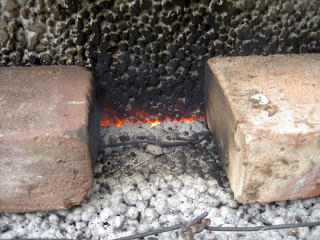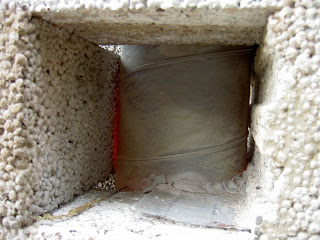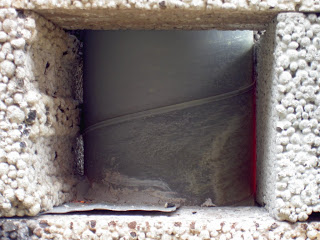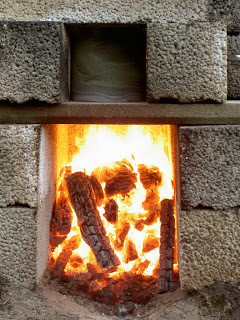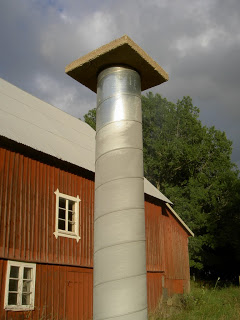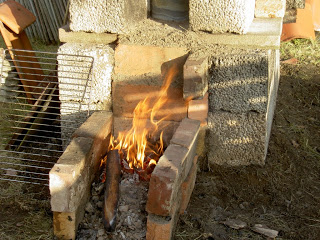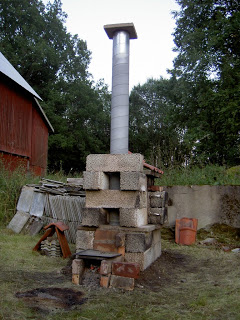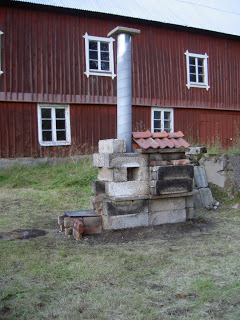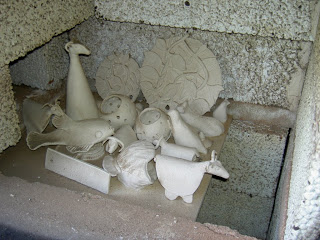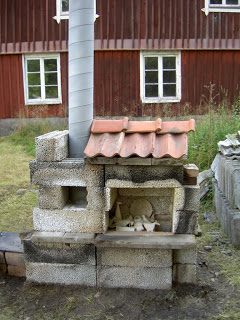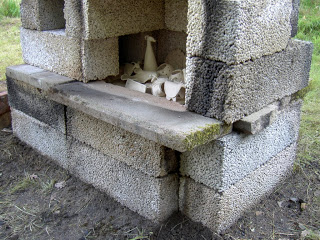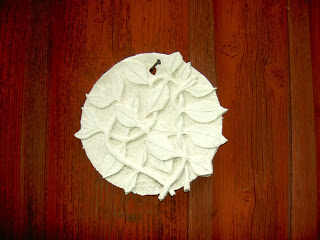| Rainy morning, bisque burn has to wait |
Exploration into smoke and fire |
Biscuit fire
If the temperature of a ceramic biscuit fire is rising to quick then the goods will explode so it is necessary to raise the temperature by 100 degrees Celsius per hour up to 600 degrees and then for higher temperatures it can be done quicker. This with the temperature makes the biscuit fire a bit tedious. Biscuit fire is also called bisque fire.
It is 20 minutes to twelve and the day starts with that the kiln is loaded with the goods.
This is the pyrometer; a thermometer that can measure the temperature up to 2000 degrees Celsius.
12:00, It is twelve a clock mid day and 19.2 degrees and this temperature is for free.
12:15, 15 minutes past twelve the temperature should be 25 degrees Celsius so I start a fire at the opening of the kiln.
In the beginning of the process the fire can be a bit difficult to control. The wood delivers much more heat when it is turned into glowing coal. Each piece of wood has its own temperature peak so to speak and in the beginning there are so few of the pieces so that each peak is showing much result on the overall heat of the fire.
12:45 Quarter to one. 75 degrees Celsius.
13:00 (1PM) One o clock. 100 degrees Celsius. It is said that you should use thin sticks of wood but I think it works just fine with normal pieces of chopped wood.
You could think that 100 degrees Celsius is the point at which water starts boiling so when that is passed it is possible to increase the temperature much faster but that is not the case. It is said that there is water molecules chemically bonded to the clay and these water molecules will not let loose until 600 degrees Celsius.
13:15 (1:15PM) Quarter past one. Big lumps of wood can initially decrease the temperature and when they start glowing they increase the temperature. Concentration!
13:45 (1:45PM) Quarter to two. 175 degrees Celsius.
Control, control and control. Heat increasing measurements, and heat decreasing measurements.
14:30 (2:30PM), Half past two. There is audience!
I was making photos of the cows so I forgot the temperature of the kiln for a moment. It deceased to 238 degrees Celsius. Really quick more thin pieces of wood to get it back to 250 degrees Celsius.
Here I am sitting and observing the pyrometer and the fire.
Here I am loading a piece of wood into the fire.
16:45 (4:45 PM) Quarter to five. At 375 degrees Celsius you can start to hear plop sounds from the lecablocks. There is almost white glow in the fire.
I make a table of temperatures to make things easier:
- 0 minutes past the hour, 0 deg past the hourly degree
- 5 min, 8 deg
- 10 min, 17 deg
- 15 min, 25 deg
- 20 min, 33 deg
- 25 min, 42 deg
- 30 min, 50 deg
- 35 min, 58 deg
- 40 min, 67 deg
- 45 min, 75 deg
- 50 min, 83 deg
- 55 min, 91 deg
Hourly degrees:
- 12:00, 0 degrees
- 13:00 (1pm), 100 degrees
- 14:00 (2pm), 200 degrees
- ...
- 18:00 (6pm), 600 degrees.
To decrease the temperature I found out you can do these things:
- Knock carefully at the top of the fire, makes it more compact.
- Drag out pieces of burning wood.
- Increase the airflow.
To increase the temperature you can do these things:
- More pieces of wood.
- Thinner pieces of wood to increase the temperature quicker.
- Move glowing coal to the top of the fire.
- Decrease the airflow.
18:00 (6PM), 600 degrees! According to all ceramic authorities 600 degrees Celsius is the critical point where it is just the pedal to the metal but this is a homemade wood burned kiln so I have no guarantee that everywhere in the kiln all goods may enjoy the temperature of 600 degrees.
18:05 (6:05PM), I put 3 chunks of wood on the fire. The temperature goes up to 650 degrees.
18:10 (6:10PM), At 610 degrees I add three chunks of wood. Temperature rise to 670 degrees.
18:15 (6:15PM), At 630 degrees I add three chunks of wood. Temperature rise to 647 degrees.
18:20 (6:20PM), At 638 degrees I add four chunks of wood. Temperature riese to 690 degrees.
18:28 (6:28PM). Pedal to the metal! Let it burn baby! Rock an roll...
18:37 (6:37PM) You can see a little peekhole. The ceramic is glowing inside.
18:37 (6:37PM) One thousand degrees Celsius!
18:37 (6:37PM) A couple of seconds later it is 1827 Fahrenheit.
18:40 (6:40PM) The roof is glowing.
18:41 (6:41PM), Photo of the chimney from the left side. The back of the chimney is glowing.
19:00 (7PM) Stopped feeding the fire. Now it need to chill down but not to quick. Let the fire die slowly.
Ideally for a biscuit burn the fire should be removed and then should the kiln be sealed so that the temperature falls slowly. It is not possible to just seal the kiln because then the goods gets into a state called reduction and it turns black. I removed the fire with a shovel when the temperature was at 600 degrees and then started to seal the kiln. The plan for how to seal the kiln failed. The blocks for this did not fit. It took time to fix an alternative plan and during this creative moment the temperature decreased to 325 degrees.
Now the kiln will rest until in the morning the day after.
8:27 (8:27AM) Eleven hours later the next day. The temperature in the kiln was 27 degrees.
The ultra thin honey suckle relief had not a single crack!
The next big thing is the preparations for the raku burn of these items.
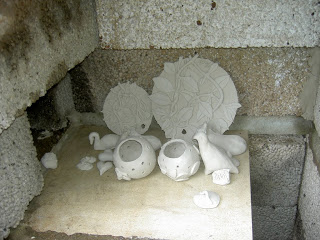
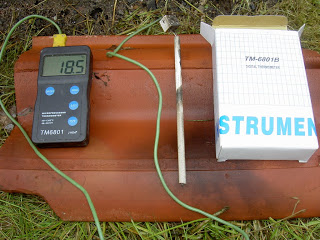
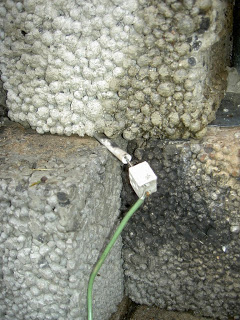
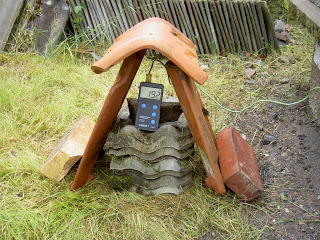
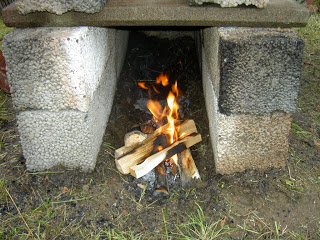
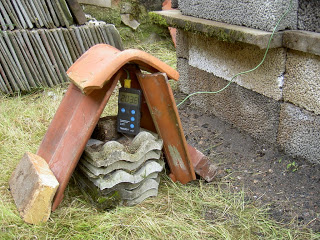
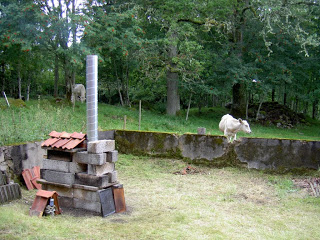
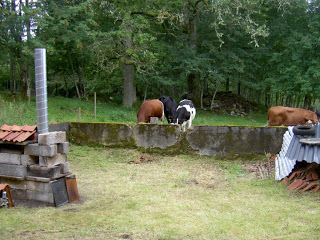
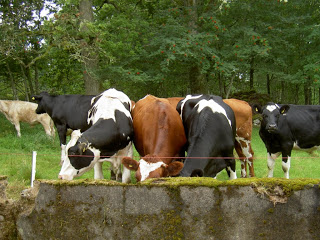
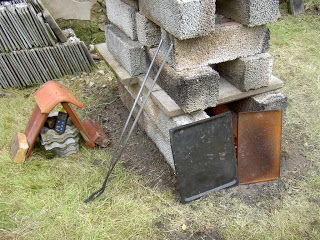
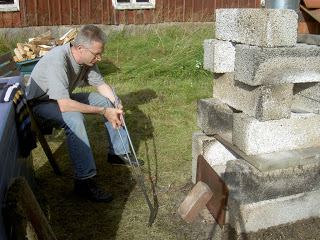
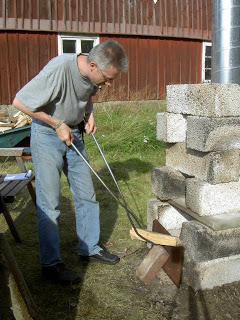
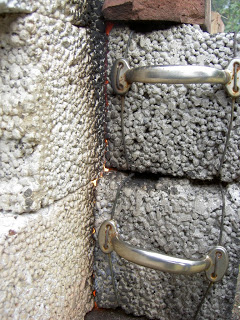
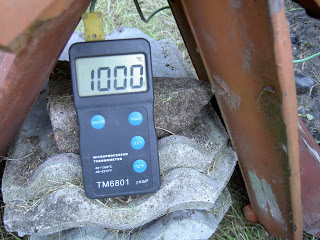
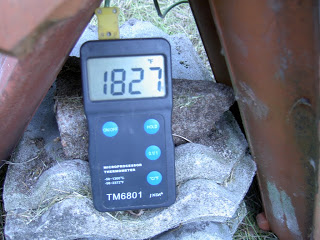 Renovation of root cellar roofMounted the winchFetched planksStayed at our CottageRepaired the washing machineCottage improvementsFront porch ornamentPainting the ceiling in the cottageSunset over Småland - Illusionistic RibbonsCurve at SunneråsMorning ViewSlender SculptureCeramic Cows, Swan, Hearts and Honeysuckle reliefsBlue Tit eating a birch tree seedPreparing hardwood plywood painting panels
Renovation of root cellar roofMounted the winchFetched planksStayed at our CottageRepaired the washing machineCottage improvementsFront porch ornamentPainting the ceiling in the cottageSunset over Småland - Illusionistic RibbonsCurve at SunneråsMorning ViewSlender SculptureCeramic Cows, Swan, Hearts and Honeysuckle reliefsBlue Tit eating a birch tree seedPreparing hardwood plywood painting panels I moved from Sweden to The Netherlands in 1995.
I moved from Sweden to The Netherlands in 1995.
Here on this site, you find my creations because that is what I do. I create.
